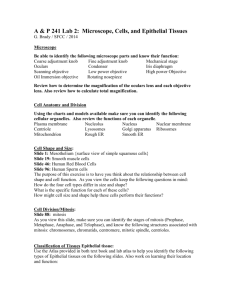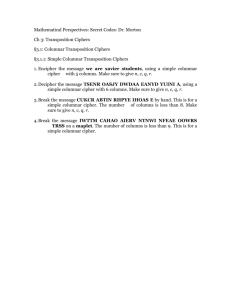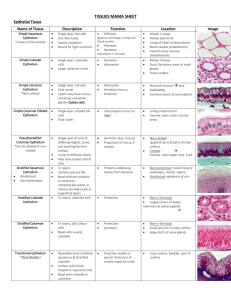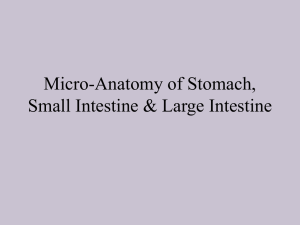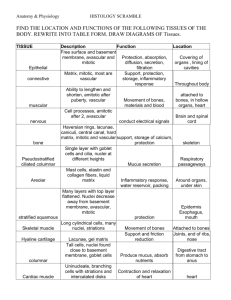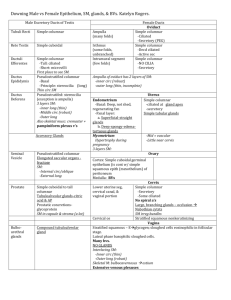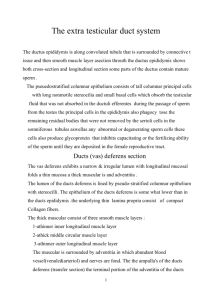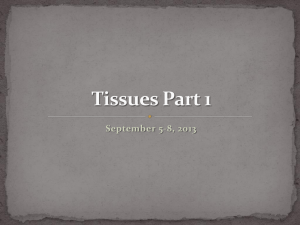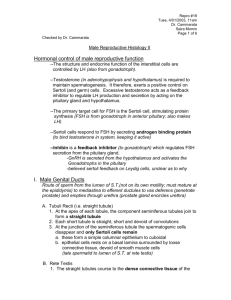SSN Histology Male Reproduction
advertisement
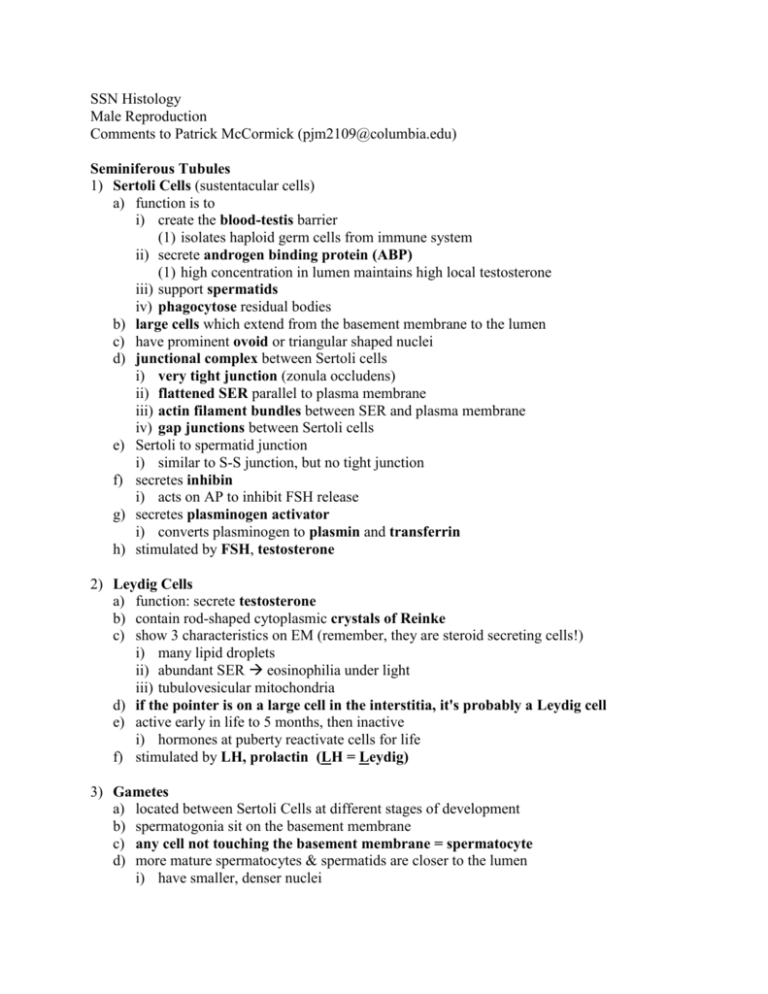
SSN Histology Male Reproduction Comments to Patrick McCormick (pjm2109@columbia.edu) Seminiferous Tubules 1) Sertoli Cells (sustentacular cells) a) function is to i) create the blood-testis barrier (1) isolates haploid germ cells from immune system ii) secrete androgen binding protein (ABP) (1) high concentration in lumen maintains high local testosterone iii) support spermatids iv) phagocytose residual bodies b) large cells which extend from the basement membrane to the lumen c) have prominent ovoid or triangular shaped nuclei d) junctional complex between Sertoli cells i) very tight junction (zonula occludens) ii) flattened SER parallel to plasma membrane iii) actin filament bundles between SER and plasma membrane iv) gap junctions between Sertoli cells e) Sertoli to spermatid junction i) similar to S-S junction, but no tight junction f) secretes inhibin i) acts on AP to inhibit FSH release g) secretes plasminogen activator i) converts plasminogen to plasmin and transferrin h) stimulated by FSH, testosterone 2) Leydig Cells a) function: secrete testosterone b) contain rod-shaped cytoplasmic crystals of Reinke c) show 3 characteristics on EM (remember, they are steroid secreting cells!) i) many lipid droplets ii) abundant SER eosinophilia under light iii) tubulovesicular mitochondria d) if the pointer is on a large cell in the interstitia, it's probably a Leydig cell e) active early in life to 5 months, then inactive i) hormones at puberty reactivate cells for life f) stimulated by LH, prolactin (LH = Leydig) 3) Gametes a) located between Sertoli Cells at different stages of development b) spermatogonia sit on the basement membrane c) any cell not touching the basement membrane = spermatocyte d) more mature spermatocytes & spermatids are closer to the lumen i) have smaller, denser nuclei Spermatogenesis & Spermiogenesis Cell Stage spermatogonia (stem cells) primary spermatocyte secondary spermatocyte spermatids spermatozoa & residual bodies Sperm Duct Pathway Duct Epithelium Tubuli Recti Simple cuboidal Rete Testis Simple cuboidal & low columnar Efferent Ductules Pseudostratified columnar & cuboidal Epididymis Duct Pseudostratified columnar Vas Deferens Pseudostratified columnar Features early: ovoid nuclei, may undergo mitosis later: spherical nuclei, committed to differentiation, all child cells linked by cytoplasmic bridges post-synthesis; 4N, diploid made by meiosis I; 2N, haploid (rarely seen) made by meiosis II; 1N, haploid Projections? none Some have a single flagellum Ciliated Function Fluid secretion Fluid secretion Stereocilia Reabsorb fluid; Sperm motility & maturation Conduit Some stereocilia Reabsorb fluid secreted in the seminiferous tubules Interstitial cells 1) Efferent Ductules a) immotile, immature sperm in lumen b) epithelia has wavy sawtooth appearance due to variable cell heights c) smooth muscle & elastic fibers d) in head of epididymus 2) Epididymus a) maturing motile sperm in lumen; decapacitation occurs i) principal (tall) cells secrete glycoproteins and sialic acid b) long stereocilia c) smooth muscle; increases in thickness from head to tail (3 layers) d) extensive Golgi apparatus, stains black with silver i) secrete products for maturation of sperm 3) Vas Deferens a) abundant smooth muscle in three layers: (blue on trichrome) i) inner longitudinal ii) middle circular iii) outer longitudinal b) cross-shaped opening in cross section c) distal end forms ampulla duct of seminal vesicle ejaculatory duct Seminal Vesicle 1) Structure a) paired glands, highly folded lumen b) non-ciliated c) no smooth muscle in these folds d) simple columnar or pseudostratified columnar epithelium, with basal cells e) folded lumen surrounded by smooth muscle layer for ejaculation. 2) Secretions a) secretes fructose, simple sugars, ascorbic acid, amino acids and prostaglandins b) lumen filled with acidophilic secretory material 3) Not for sperm storage Prostate Gland 1) Structure a) surrounded by a fibroelastic capsule b) incomplete septa divide prostate into lobules c) parenchyma has tubulo-alveolar glands that secrete into the urethra on ejaculation i) embedded in dense fibro-elastic connective tissue interlaced with smooth muscle d) simple or pseudostratified columnar epithelium 2) innervated by sympathetic nervous system (Sympathetic = Shoot) 3) prostatic urethra = portion of urethra that passes through the prostate a) has transitional epithelium lining b) becomes (pseudo)stratified columnar distal to ejaculatory ducts 4) Secretes citric acid, acid phosphatase, and fibrinolysin (liquefies semen) a) also serine protease (PSA), produced by liver 5) concretions (corpora amylacea) occur in the glandular lumens, increase with age a) They are good markers! Penile Cross Section 1) corpus spongiosum ventral erectile tissue a) surrounds penile urethra & deep arteries, forms glans 2) corpora cavernosa dorsal erectile tissue, paired a) sinuses are lined with vascular endothelium 3) tunica albuginea is a dense fibrous elastic layer surrounding erectile tissue a) forms capsule of testis 4) penile urethra a) stratified columnar/cuboidal epithelium. b) glands of Littre are mucous secreting glands along lumen


